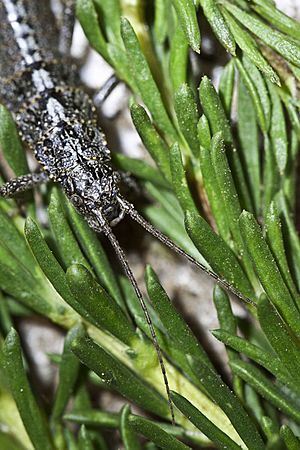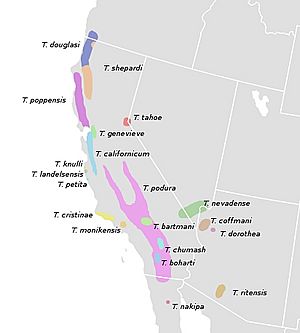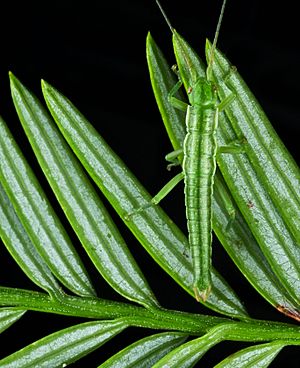Timema facts for kids
Quick facts for kids Timema |
|
|---|---|
 |
|
| Timema genevievae on the leaves of chamise (Adenostoma fasciculatum). | |
| Scientific classification |
|
| Kingdom: | Animalia |
| Phylum: | Arthropoda |
| Class: | Insecta |
| Order: | Phasmatodea |
| Family: | Timematidae |
| Genus: | Timema Scudder, 1895 |
| Species | |
|
21, and see text |
|
 |
|
| Geographical distribution of Timema species in North America (Law & Crespi, 2002). T. morongense is found west of T. chumash but the extent of its full range is unknown. | |

Timema is a type of short, thick stick insect. These insects live in the far western United States.
Compared to other stick insects, Timema are very special. They are the oldest living group of stick insects. This means they were the first to split off from all other stick insects. Sometimes, all other stick insects are called "Euphasmatodea" to show this difference.
How Timema Reproduce
There are 21 known species of Timema. Five of these species can reproduce without a male. This is called parthenogenesis.
Two of these species have reproduced without a male for a million years! This is the longest time known for any insect to reproduce this way.
Blending In: Camouflage
Timema stick insects are active at night. They eat leaves and bark when it is dark. During the day, they rest on the plants they feed on.
They are masters of camouflage. Timema species have colors like green, gray, or brown. They also have patterns like stripes or dots. These colors and patterns help them blend in perfectly with their background. This makes them very hard for predators to spot.
Images for kids
-
Timema cf. californicum from the Santa Lucia Mountains of California.
See also
 In Spanish: Timema para niños
In Spanish: Timema para niños


